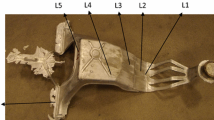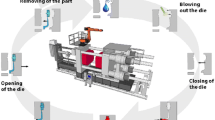Abstract
Porosity formation in high pressure die casting (HPDC) impacts mechanical properties and casting quality. Much is published regarding micro porosity and its impact on mechanical properties, but there is limited research on the actual formation of macro porosity. In production applications, macro porosity plays a critically important role in casting quality and acceptance by the customer. This paper argues that the most useful definition of macro porosity is the limits of visual detectability. With this definition, it will be shown macro porosity presents stochastically within a controlled HPDC process. This means macro porosity has a random probability distribution or pattern that should be analyzed statistically and cannot be predicted precisely. The general region where macro porosity forms is predictable with simulation, but its actual size and distribution of the voids are random. These results challenge the industry accepted practices for inspections and process controls. This also underscores the importance of up-front design for manufacturability to avoid macro porosity-related quality issues.






Similar content being viewed by others
Availability of data and material
Not applicable.
References
J. Brevick, Die Casting Porosity Guidebook. North American Die Casting Association, 2008.
W.G. Walkington, Die Casting Defects: Causes and Solutions (North American Die Casting Association, Rosemont, IL, 1997).
D. Twarog, “State of the Industry 2012.” North American Die Casting Association, 2012, [Online]. https://www.diecasting.org/archive/dce/212online2.pdf.
J. Folk, “U.S. Aluminum Casting Industry - 2019,” Die Casting Engineer, vol. July 2019, 2019.
S. Midson, “Report on the 2014 Die Casting Benchmarking Survey Part 2 of 3: Operations,” in Report on the 2014 Die Casting Benchmarking Survey, North American Die Casting Association, 2014.
S. Viswanathan et al., Eds., “Shrinkage Porosity and Gas Porosity,” In: Casting, ASM International, 2008, pp. 370–374. https://doi.org/10.31399/asm.hb.v15.a0005222
P.D. Lee, A. Chirazi, D. See, Modeling microporosity in aluminum–silicon alloys: a review. J. Light Met. 1(1), 15–30 (2001). https://doi.org/10.1016/S1471-5317(00)00003-1
J. Campbell, Castings, 2nd edn. (Butterworth-Heinemann, Oxford, 2003).
E. Fiorese, F. Bonollo, G. Timelli, L. Arnberg, E. Gariboldi, New classification of defects and imperfections for aluminum alloy castings. Int. J. Met. 9(1), 55–66 (2015). https://doi.org/10.1007/BF03355602
H.H. Doehler, Die Casting (McGraw-Hill Book Company, New York, 1951).
NADCA Product Specification Standards for Die Casting, 10th Edition. Arlington Heights, IL: North American Die Casting Association, 2018.
R. Atwood, “A Combined Cellular Automata and Diffusion Model for the Prediction of Porosity Formation During Solidification,” University of London, 2001.
Product Design for Die Casting E-606, Sixth Edition., vol. E-606. North American Die Casting Association, 2009.
I. Brill, B. Kappes, and S. Midson, An Initial Evaluation of CT Scanning for Measuring and Characterizing Porosity in Aluminum Die Castings, Indianapolis, IN, 2018, vol. T18-083. http://www.diecasting.org/archive/transactions/T18-083.pdf
M. Weidt, R.A. Hardin, C. Garb, J. Rosc, R. Brunner, C. Beckermann, Prediction of porosity characteristics of aluminium castings based on X-ray CT measurements. Int. J. Cast Met. Res. (2018). https://doi.org/10.1080/13640461.2018.1467105
C. Gu, Y. Lu, A.A. Luo, Three-dimensional visualization and quantification of microporosity in aluminum castings by X-ray micro-computed tomography. J. Mater. Sci. Technol. 65, 99–107 (2021). https://doi.org/10.1016/j.jmst.2020.03.088
H. Cao, M. Hao, C. Shen, P. Liang, The influence of different vacuum degree on the porosity and mechanical properties of aluminum die casting. Vacuum 146, 278–281 (2017). https://doi.org/10.1016/j.vacuum.2017.09.048
X.P. Niu, B.H. Hu, I. Pinwill, H. Li, Vacuum assisted high pressure die casting of aluminium alloys. J. Mater. Process. Technol. 105(1–2), 119–127 (2000). https://doi.org/10.1016/S0924-0136(00)00545-8
Y. Zhang, E. Lordan, K. Dou, S. Wang, Z. Fan, Influence of porosity characteristics on the variability in mechanical properties of high pressure die casting (HPDC) AlSi7MgMn alloys. J. Manuf. Process. 56, 500–509 (2020). https://doi.org/10.1016/j.jmapro.2020.04.071
J. A. Dantzig and M. Rappaz, Solidification, 1 st. EPFL Press, 2009
J. Huang, J.G. Conley, Modeling of microporosity evolution during solidification processes, in Review of progress in quantitative nondestructive evaluation. ed. by D.O. Thompson, D.E. Chimenti, (Springer, US, 1998), pp. 1839–1846
T. Liang, C. Mobley, N. Tsumagari, “The Effects of Shot Delay Time on the Microstructures and Mechanical Properties of a Die Cast Aluminum Alloy”, Presented at the Die Casting Toward The Future (Rosemont, IL, 2002). https://www.diecasting.org/archive/transactions/T02-053.pdf
B. Zhang, S.L. Cockcroft, D.M. Maijer, J.D. Zhu, A.B. Phillion, Casting defects in low-pressure die-cast aluminum alloy wheels. JOM 57(11), 36–43 (2005). https://doi.org/10.1007/s11837-005-0025-1
K.D. Carlson, C. Beckermann, Prediction of shrinkage pore volume fraction using a dimensionless Niyama criterion. Metall. Mater. Trans. A 40(1), 163–175 (2009). https://doi.org/10.1007/s11661-008-9715-y
G.K. Sigworth, Shrinkage, feeding and riser design. AFS Trans. 14(002), 25–36 (2014)
M. Shabani, A. Mazahery, Prediction of mechanical properties of cast A356 alloy as a function of microstructure and cooling rate. Arch. Metall. Mater. (2011). https://doi.org/10.2478/v10172-011-0073-1
M. Easton, C. Davidson, D. St John, Effect of alloy composition on the dendrite arm spacing of multicomponent aluminum alloys. Metall. Mater. Trans. A 41(6), 1528–1538 (2010). https://doi.org/10.1007/s11661-010-0183-9
J. Cho, C. Kim, The relationship between dendrite arm spacing and cooling rate of Al-Si casting alloys in high pressure die casting. Int. Metalcasting 8(1), 49–55 (2014). https://doi.org/10.1007/BF03355571
“SRE MAX,” Bosello High Technology , a ZEISS company. https://bosello.eu/products/sre-max/. Accessed 29 Dec 2020
“Phoenix Vtomex C | 3D CT Scanner (Mini Focus),” Waygate Technologies. https://www.bakerhughesds.com/industrial-x-ray-ct-scanners/phoenix-vtomex-c-ct. Accessed 29 Dec 2020
“Xradia 610 & 620 Versa.” https://www.zeiss.com/microscopy/us/products/x-ray-microscopy/zeiss-xradia-610-and-620-versa.html. Accessed 29 Dec 2020
T.J. Schorn, Improving the Effectiveness of Visual Inspection (American Foundry Society, Schaumburg, IL USA, 2018).
J.F. Koretz, G.H. Handelman, How the human eye focuses. Sci. Am. 259(1), 92–99 (1988). https://doi.org/10.1038/scientificamerican0788-92
J. Schindelin et al., Fiji: an open-source platform for biological-image analysis. Nat. Methods 9(7), 676–682 (2012). https://doi.org/10.1038/nmeth.2019
S. Preibisch, S. Saalfeld, J. Schindelin, P. Tomancak, Software for bead-based registration of selective plane illumination microscopy data. Nat. Methods 7(6), 418–419 (2010). https://doi.org/10.1038/nmeth0610-418
ASTM E505–15, Standard reference radiographs for inspection of aluminum and magnesium die castings E505–15. ASTM International (2015). https://doi.org/10.1520/E0505-15
S.S. Shapiro, M.B. Wilk, An analysis of variance test for normality (complete samples). Biometrika 52, 591–611 (1965)
F. Wilcoxon, Individual comparisons by ranking methods. Biom. Bull. 1(6), 80–83 (1945)
MAGMAsoft. Kackerstrasse 11, 52072 Aachen, Germany: MAGMA Gmbh, 2019
M.R. Brand, An examination of certain Bayesian methods used in reliability analysis. Reliab. Eng. 1(2), 115–125 (1980). https://doi.org/10.1016/0143-8174(80)90003-7
V.D. Tsoukalas, Optimization of porosity formation in AlSi9Cu3 pressure die castings using genetic algorithm analysis. Mater. Des. 29(10), 2027–2033 (2008). https://doi.org/10.1016/j.matdes.2008.04.016
S.G. Lee, A.M. Gokhale, Formation of gas induced shrinkage porosity in Mg-alloy high-pressure die-castings. Scr. Mater. 55(4), 387–390 (2006). https://doi.org/10.1016/j.scriptamat.2006.04.040
Q.-C. Hsu, A.T. Do, Minimum porosity formation in pressure die casting by taguchi method. Math. Probl. Eng. 2013, 1–9 (2013). https://doi.org/10.1155/2013/920865
J. Zheng, Q. Wang, P. Zhao, C. Wu, Optimization of high-pressure die-casting process parameters using artificial neural network. Int. J. Adv. Manuf. Technol. 44(7–8), 667–674 (2009). https://doi.org/10.1007/s00170-008-1886-6
F. Bonollo, N. Gramegna, G. Timelli, High-pressure die-casting: contradictions and challenges. JOM 67(5), 901–908 (2015). https://doi.org/10.1007/s11837-015-1333-8
D. Blondheim Jr., “Unsupervised Machine Learning and Statistical Anomaly Detection Applied to Thermal Images”, Presented at the 2018 NADCA Congress and Exposition (Indianapolis, IN, 2018). http://www.diecasting.org/archive/transactions/T18-071.pdf
C.H. Cáceres, B.I. Selling, Casting defects and the tensile properties of an AlSiMg alloy. Mater. Sci. Eng. A 220(1–2), 109–116 (1996). https://doi.org/10.1016/S0921-5093(96)10433-0
R. Lumley, N. Deeva, M. Gershenzon, An evaluation of quality parameters for high pressure die castings. Int. J. Met. 5(3), 37–56 (2011). https://doi.org/10.1007/BF03355517
Funding
Research was sponsored by Mercury Marine – Mercury Castings, a division of Brunswick, Inc.
Author information
Authors and Affiliations
Corresponding author
Ethics declarations
Conflict of interests
Research was completed as part of requirements for an author’s PhD degree.
Code availability
Not applicable.
Additional information
Publisher's Note
Springer Nature remains neutral with regard to jurisdictional claims in published maps and institutional affiliations.
Rights and permissions
About this article
Cite this article
Blondheim, D., Monroe, A. Macro Porosity Formation: A Study in High Pressure Die Casting. Inter Metalcast 16, 330–341 (2022). https://doi.org/10.1007/s40962-021-00602-x
Received:
Accepted:
Published:
Issue Date:
DOI: https://doi.org/10.1007/s40962-021-00602-x




